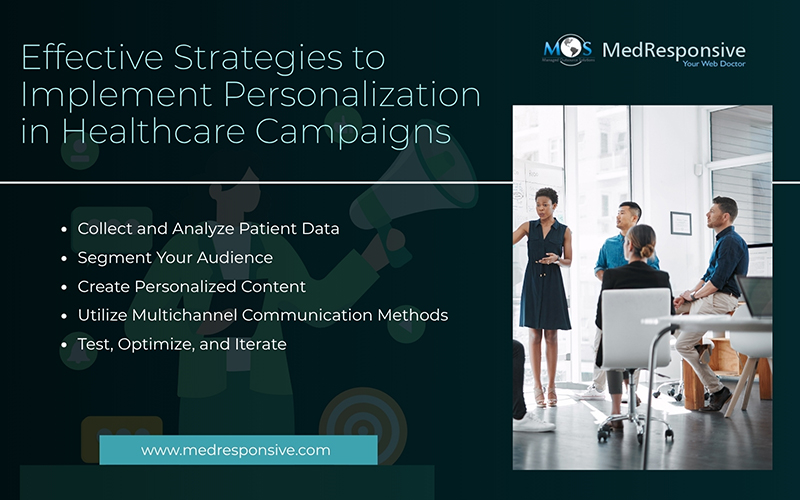In today’s healthcare industry, one-size-fits-all marketing strategies are becoming increasingly ineffective. Patients expect tailored experiences that speak directly to their needs, values, and preferences. As a result, customized healthcare marketing campaigns that focus on personalization in healthcare campaigns are growing in demand, as they improve patient engagement, drive brand loyalty, and ultimately foster better outcomes. Medical organizations can choose to partner with firms that outsource healthcare digital marketing strategies to deliver targeted communication and drive better healthcare experiences as well as improved patient loyalty.
Why Personalization Matters in Healthcare
Personalization refers to tailoring content, messaging, and services to fit the unique needs, preferences, and behaviors of each individual. In healthcare, this could mean providing tailored health tips, sending medication reminders, or creating personalized treatment plans based on a patient’s medical history, specific health concerns, or health goals. Here’s why personalized healthcare campaigns are important:
- Better Outcomes: Personalization can lead to improved healthcare results by providing patients with tailored advice, reminders, and resources. This approach leads to better adherence to treatment plans, enhances customer experience, and ultimately results in healthier outcomes.
- Improved Patient Engagement: When campaigns are tailored to individual needs, they tend to connect better with patients. This leads to increased patient engagement, lower readmissions, and increased patient satisfaction.
- Increased ROI: Campaigns that are personalized typically see higher response rates, better retention rates, and improved conversion rates, ultimately boosting ROI for healthcare providers.
How to Personalize Healthcare Marketing Campaigns
Medical organizations can implement effective methods to leverage personalization in marketing strategies, stay connected with the audience and achieve better results.
- Collect and Analyze Patient Data
Data is the backbone of any successful personalized marketing campaign. Healthcare organizations should implement a robust data collection strategy for accurate and relevant patient data to tailor effective personalized messages. By gathering data from various touch points across the patient journey, you can enhance personalization efforts:
- Demographic data: Basic information such as age, gender, and location can help determine what healthcare products or services may be most relevant to a specific patient. For example, a campaign aimed at elderly patients may need to focus on mobility and medication management, while a campaign targeting young parents might focus on child health and preventative care.
- Health data: Understanding a patient’s details such as medical history, chronic conditions, medications, and allergies could enable healthcare providers to provide targeted health advice, reminders, or product recommendations.
- Behavioral data: Monitor and segment how patients interact with your practice’s digital channels such as website, app, and emails. This will give you insights into the type of content that resonates with patients and tailor campaigns through preferred communication channels.
By collecting, organizing, and analyzing this data, healthcare marketers can turn raw data into actionable insights, ensuring that they deliver highly relevant and impactful campaigns.
- Segment Your Audience
Once you have access to patient data, the next step is to segment your audience into groups with similar needs, characteristics, or behaviors. Segmentation is the key element of effective personalization and helps ensure that your message resonates with the right people. Providers can segment their audience based on common segmentation methods, such as:
- Demographic segmentation: Grouping patients based on age, gender, or location can be an easy way to tailor campaigns. For example, young adults may be more interested in fitness programs, while seniors might be more focused on chronic disease management.
- Condition-based segmentation: This involves grouping patients based on specific health conditions or concerns. For example, content targeting diabetes patients may provide relevant lifestyle tips, dietary advice, or medication reminders.
- Behavioral segmentation: By analyzing how patients interact with previous campaigns, you can segment them based on behavioral levels. For example, some patients may respond well to educational content, while others prefer appointment reminders or offers for discounted healthcare services.
By creating different segments, healthcare organizations can personalize content and messaging to align with each group’s unique needs, ensuring more targeted and effective interactions with patients.
- Create Personalized Content
Once you’ve segmented your audience, the next step is to craft personalized messaging and content that speaks directly to their needs and interests. It can be as simple as addressing a patient by name or as complex as tailoring specific treatment recommendations based on their medical history. This is where your data and segmentation efforts come into play.
Here are a few ways to create personalized content:
- Educational Web Content: Medical facilities can provide targeted educational website materials based on the patient’s condition or interests. For instance, patients with hypertension might be interested in articles on managing blood pressure, while individuals interested in mental health may appreciate resources on managing stress or anxiety.
- Personalized Email Campaigns: One of the most effective ways to deliver personalized content is through email. Healthcare providers can send targeted emails with specific health tips, reminders for check-ups, or tailored content based on a patient’s medical history.
- Appointment Reminders: Personalized appointment reminders can be sent via text, email, or app notifications, increasing engagement rates and reducing downtimes for practices.
- Targeted Social Media Campaigns: Social media platforms such as Facebook, Instagram, and X allow for targeted ads based on user behaviors, location, and interests. Healthcare marketers can use these social media platforms to target patients with relevant content based on their previous interactions.
Tailoring content ensures that patients feel heard, valued, and understood, which ultimately leads to better provider-patient relationships, improved satisfaction, and increased return on investment.
- Utilize Multichannel Communication Methods
Personalization should not be limited to just one communication channel. Providers can interact with patients across various platforms, including emails, websites, social media, and phone calls. By using a multichannel approach, you can reach audiences where they are most active.
- Omni channel integration: Make sure your messaging and branding are consistent across all channels, whether it’s an email, social media ad, or a text message reminder. This creates a seamless user experience and strengthens brand recognition.
- SMS and push notifications: Text messages tend to have higher engagement rates, especially for reminders, medication alerts, or emergency notifications. They can be effective for engaging busy patients who may not check email regularly.
- Mobile apps: If your healthcare facility provides a mobile app, it can serve as an ideal platform for personalized notifications, health tips, and appointment reminders.
By adopting multichannel integration, you can deliver a consistent user experience across various touch points, ensuring that the right message is delivered to the right audience.
- Test, Optimize, and Iterate
Personalization is an ongoing process that requires constant optimization. Continuously monitor the performance of your campaigns and make necessary adjustments as needed.
- A/B testing: Regularly test different versions of emails, ads, and other personalized content to understand what resonates with different segments of your audience.
- Patient feedback: Collect feedback through online forms or surveys from patients regarding their experiences with your personalized campaigns. Use this information to refine your marketing approach.
- Behavioral tracking: Use analytics tools to monitor how patients interact with your campaigns and adjust your strategy to identify areas of improvement, reduce bounce rates, and improve engagement rates.
By following these healthcare marketing best practices, practitioners can streamline patient communication, ensuring that every interaction delivers meaningful, impactful results.
Leverage Personalization with Outsourcing
Practices can leverage personalization in their marketing efforts effectively by outsourcing to a reliable healthcare SEO agency. As healthcare continues to evolve, personalized marketing is not just a trend but a strategic shift towards more targeted, patient-centric service.
By utilizing digital marketing solutions for healthcare providers, practices can ensure their campaigns are data-driven and customized to meet the unique needs of their audience, without the need for extensive in-house resources. With the demand for individualized care on the rise, integrating personalization into healthcare campaigns will be crucial for providers looking to stay competitive and run a thriving practice.





